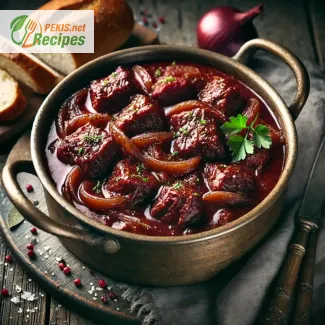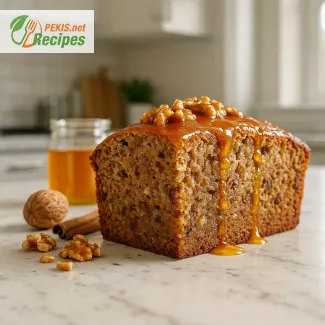
Introducing the ultimate comfort food for cold days and cozy nights: Beef Goulash with Red Wine. This traditional dish, perfected over centuries, is not just another beef stew – it’s a masterpiece of rich flavors and aromatic spices. Slow-cooked to perfection, each bite of tender beef melts in your mouth, enveloped in a sauce that’s been lovingly simmered with red wine, herbs, and spices for hours, letting every ingredient shine.
The base of this beef goulash starts with carefully selected, high-quality beef, cut into bite-sized pieces that become incredibly tender through the slow-cooking process. With the deep, robust flavors of red wine, the sauce develops a complexity that is hearty yet sophisticated. Red wine doesn’t just add depth; it enhances the beef’s natural richness, creating a bold yet balanced taste profile that will leave you savoring each mouthful.
Caramelized onions are the backbone of this goulash, adding a touch of sweetness that offsets the wine’s acidity and harmonizes with the spices. The sauce thickens as it cooks, turning into a velvety, luxurious gravy that coats every piece of beef. Each spoonful delivers the warmth of paprika, the spice of black pepper, and the earthiness of bay leaves and thyme, balancing together in a symphony of flavors. Garlic and tomatoes add another layer of depth, making each bite as complex as it is comforting.
This Beef Goulash with Red Wine isn’t just food; it’s a culinary experience that celebrates the art of slow cooking. The hours spent in a gentle simmer allow every ingredient to meld, enhancing the natural flavors and creating a meal that’s as satisfying as it is delicious. The aroma alone is mouthwatering – imagine coming home to the smell of rich beef and wine, infused with spices, wafting through your kitchen.
Perfect for family gatherings or an indulgent meal on a quiet night, this hearty goulash pairs beautifully with a crusty loaf of bread to soak up the sauce or a side of buttery mashed potatoes. And as it sits and cools, the flavors continue to deepen, making this dish even more delicious the next day. It’s a meal that ages gracefully, and its flavor intensifies over time, perfect for those who appreciate leftovers that taste even better.
Every ingredient in this classic beef goulash recipe serves a purpose, each chosen to create layers of flavor that bring out the best in the beef and wine. The red wine reduction process amplifies the depth of the sauce, resulting in a rich, intense flavor that is nothing short of gourmet. This dish is not just about satisfying hunger – it’s about savoring every bite, immersing yourself in the taste and texture of each carefully crafted element.
This goulash is a tribute to European culinary tradition, taking inspiration from Hungarian roots and adding a modern twist with the red wine infusion. Whether you’re cooking for a special occasion or simply seeking comfort in a bowl, this Beef Goulash with Red Wine is the perfect choice. It’s a dish that respects the art of slow cooking, using time as an ingredient to unlock its full potential. So, indulge in this sumptuous meal and experience beef goulash like never before – full-bodied, warming, and truly unforgettable.
- Prepare the Ingredients: Start by cutting the beef into bite-sized cubes. Thinly slice the onions and mince the garlic.
- Brown the Beef: Heat the olive oil in a large, heavy-bottomed pot over medium-high heat. Add the beef cubes in batches, browning each piece on all sides. Remove the beef from the pot and set aside.
- Sauté the Vegetables: In the same pot, add the sliced onions and cook until caramelized, about 10 minutes. Add the garlic and cook for another minute until fragrant.
- Add the Flour: Sprinkle the flour over the onions and garlic, stirring continuously for 2 minutes. This helps thicken the sauce.
- Deglaze with Red Wine: Pour in the red wine, scraping up any browned bits from the bottom of the pot. Let it simmer for 2-3 minutes until the wine reduces by half.
- Add Remaining Ingredients: Add the browned beef back into the pot along with beef stock, tomato paste, sweet paprika, bay leaf, thyme, salt, and black pepper. Stir well to combine.
- Slow Cook: Bring the mixture to a boil, then reduce the heat to low. Cover the pot and let it simmer for 2 to 2½ hours, stirring occasionally. The beef should be tender and the sauce thick and rich.
- Serve: Remove the bay leaf and adjust the seasoning if necessary. Serve hot with bread or mashed potatoes.
Creating a rich and flavorful Beef Goulash with Red Wine offers ample opportunities for variation and personalization. Here are several tips and techniques to elevate the dish, allowing for adjustments based on dietary preferences, ingredient availability, and taste enhancements. These strategies ensure a well-rounded culinary experience and allow each cook to adapt this classic recipe while keeping its deep, comforting flavors intact.
1. Enhancing the Flavor Depth
- Wine Selection: The choice of red wine profoundly influences the flavor profile. For a more robust, full-bodied taste, select a Cabernet Sauvignon or Merlot. For a smoother, slightly fruitier flavor, try a Pinot Noir. The wine’s tannins will soften during cooking, adding subtle complexity without overpowering the beef.
- Additional Herbs and Spices: While the traditional spices used in this goulash are paprika, bay leaves, and thyme, consider adding a small sprig of rosemary or a pinch of ground cumin for an earthy twist. Caraway seeds are also a classic choice in some regions, enhancing the overall depth with their subtle anise-like aroma.
- Balsamic Vinegar Finish: Toward the end of the cooking process, a dash of balsamic vinegar can add a touch of acidity, balancing the richness and intensifying the flavors. Add 1-2 teaspoons (5-10 ml) just before serving for a bright finish.
2. Optimizing the Texture
- Choosing the Right Cut of Beef: For the best results, select cuts of beef known for their flavor and tenderness when slow-cooked, such as chuck, shin, or brisket. These cuts hold up well to long cooking times, breaking down to become tender and succulent without falling apart entirely.
- Proper Browning: Browning the beef thoroughly is a crucial step for flavor development. Ensure the pieces are not crowded in the pan, as this can lead to steaming rather than browning. Browning creates a Maillard reaction, enhancing the savory flavors of the goulash. Remove the beef from the pan only when it has a deep, golden crust.
- Adding Vegetables for Thickening: If a thicker goulash is desired without extra flour, add a few chopped carrots or celery stalks along with the onions. These vegetables break down during the long cooking process, naturally thickening the sauce and adding extra body.
3. Adjusting for Dietary Preferences and Restrictions
- Gluten-Free Option: To make this dish gluten-free, replace the all-purpose flour with a gluten-free flour blend or cornstarch. If using cornstarch, dissolve it in a small amount of cold water first to create a slurry, then add it gradually to the goulash. This will prevent lumps and create a smooth, thick sauce.
- Low-Sodium Version: Opt for a low-sodium beef stock or make your own to better control salt levels. You can also reduce the salt in the recipe, then taste and adjust as needed after cooking.
- Reducing Saturated Fat: To lower the saturated fat content, use a leaner cut of beef and reduce the amount of olive oil to 1 tablespoon (15 ml). Additionally, after browning the meat, you can blot the beef with a paper towel to remove excess fat before adding it back to the pot.
4. Vegetable Additions for a Nutritious Twist
- Root Vegetables: Root vegetables like parsnips, turnips, or potatoes can be added for extra nutrition and texture. They add slight sweetness and natural thickness, making the goulash heartier and more filling.
- Bell Peppers: For a hint of color and additional vitamins, include a few chopped red or green bell peppers. Add these toward the end of cooking, as they don’t require long simmering to become tender.
- Tomatoes: While tomato paste is used for a concentrated flavor, adding fresh or canned tomatoes (200-300 g, about 1 cup) can make the dish lighter and add acidity to balance the beef and wine.
5. Improving the Health Benefits
- Incorporating Fiber: If you’re looking to add fiber, serve the goulash with a side of whole-grain bread or brown rice. This pairing complements the dish’s flavors and adds nutritional value.
- Boosting Antioxidants: To increase antioxidant content, you can add extra garlic or a handful of chopped fresh parsley at the end. Parsley is rich in vitamins C and A, both of which contribute to immune function and skin health.
- Adding Leafy Greens: Another option is to stir in a handful of spinach or kale during the last few minutes of cooking. These greens wilt quickly, add color, and boost the dish’s vitamin A and K content.
6. Perfecting the Sauce Consistency and Color
- Using Tomato Paste Effectively: Tomato paste is essential for a rich, slightly acidic flavor that complements the red wine. Cooking the tomato paste for 2-3 minutes before adding the other liquids helps deepen its flavor and caramelizes its natural sugars, enriching the sauce.
- Reducing the Sauce for Thickness: If your goulash is too thin after cooking, remove the lid and allow it to simmer uncovered for an additional 15-20 minutes. This reduction intensifies the flavor and thickens the sauce naturally.
7. Presentation Tips for Serving
- Garnishing for Freshness: A sprinkle of fresh parsley or chives just before serving adds a pop of color and a mild, fresh flavor that balances the goulash’s richness.
- Serving with Sides: Classic accompaniments include crusty bread, mashed potatoes, or buttered noodles. These sides complement the rich sauce and provide a satisfying base that absorbs the goulash’s flavors. For a lighter option, consider serving with steamed vegetables or a simple green salad to cut through the richness.
8. Storage and Reheating Tips
- Storing Leftovers: This goulash stores well and often tastes even better the next day. Store in an airtight container in the refrigerator for up to 3 days.
- Freezing: Beef goulash can be frozen for up to 3 months. For best results, cool the dish completely before freezing and avoid adding any fresh herbs until reheating, as these can lose flavor when frozen.
- Reheating: When reheating, do so over low heat on the stovetop, adding a splash of beef stock or water if the sauce has thickened too much. Stir occasionally to ensure even warming and prevent burning.
9. Experimenting with International Variations
- Hungarian Goulash Twist: Add Hungarian hot paprika for a slight heat and omit the wine for a more traditional touch. Hungarian goulash traditionally relies on paprika and occasionally caraway seeds rather than wine for its unique flavor.
- Italian-Inspired Variation: Substitute red wine with Marsala wine and add a dash of oregano for an Italian-inspired twist on the classic. This adaptation pairs beautifully with polenta or risotto for a comforting Mediterranean meal.
- Smoky Flavor: Add smoked paprika or a few strips of bacon when browning the beef to infuse the dish with a subtle, smoky aroma that enhances its rustic quality.
10. Nutritional Benefits and Key Components
- Iron-Rich Meal: The beef provides a high amount of iron, which is essential for oxygen transport in the blood. This makes the dish particularly beneficial for individuals with iron deficiency or high physical activity levels.
- Antioxidant Power: Red wine contributes to the antioxidant content of the goulash due to its polyphenols, which help combat free radicals and support heart health.
- Protein Boost: Each serving is packed with approximately 32 grams of protein, aiding in muscle repair, immune support, and general body function.
With a few strategic adjustments, Beef Goulash with Red Wine can be tailored to suit a range of preferences and dietary needs, making it a versatile and satisfying meal for any occasion. From boosting nutritional benefits to exploring unique variations and accommodating allergies, this dish provides a culinary canvas for chefs of all levels. Let the aroma of simmering beef, wine, and spices fill your kitchen, and enjoy a meal that celebrates the art of slow cooking and the deep flavors it brings.
This recipe contains gluten due to the use of all-purpose flour. For a gluten-free option, replace the flour with cornstarch or a gluten-free flour blend. Ensure that the beef stock is also gluten-free, as some brands may contain gluten.
- Iron: Supports oxygen transport and energy production (4 mg per serving).
- Vitamin B12: Essential for nervous system health and red blood cell formation (2.4 mcg per serving).
- Zinc: Aids immune function and protein synthesis (5 mg per serving).
- Potassium: Helps maintain fluid balance and muscle function (700 mg per serving).
- Vitamin C (from onions and garlic): Boosts immune function and skin health.
- Polyphenols (from red wine): Supports cardiovascular health and reduces oxidative stress.





